Penalty Virtual Element Method for the 3D Incompressible Flow on Polyhedron Mesh
Abstract
:1. Introduction
2. The Stationary Penalty Stokes Equations
- and are continuous, i.e.,
- is coercive, i.e., there exists a positive constant such that
- Moreover, the bilinear form satisfies the - condition: where there exists a constant such that
3. The Penalty Virtual Element Method for Stokes Equations
- each polyhedron is star-shaped with respect to every point of a ball of radius ;
- for every face we have and f is star-shaped with respect to every point of a disk of radius ;
- for every edge , we have
- the value of at the vertices of K;
- on each edge e, the value of at the internal points of the -points Gauss–Lobatto quadrature rule on e;
- for each face f the moments up to order of in f:where the scaled monomials are defined by
- the moments up to order of in K:where the scaled monomials are defined in (1.5), and by
3.1. Constructing the Discrete Matrix
- k-compatibility: if , have
- Stability: there are two positive constants and dependent on and K, have
- Computability: we can know the computability of the discrete bilinear form from Remark 1.
3.2. Theoretical Analysis
4. Numerical Experiments
- -norm: ;
- -norm: .
4.1. Smooth Solution
4.2. True Solution
4.3. Driven Cavity Flow
5. Conclusions
Author Contributions
Funding
Data Availability Statement
Acknowledgments
Conflicts of Interest
Nomenclature
| P | pressure |
| u | dimensionless velocity components |
| penalty parameter | |
| L2-orthogonal projection | |
| H1 projection operator | |
| P | projection operator of constant functions |
| K | polyhedral element |
| f | face of polyhedral element |
| N | dimension of shape function space |
| h | diameter of polyhedral element |
| e | ridge of polyhedral element |
| mesh generation | |
| h | diameter of face of polyhedral element |
References
- Carey, G.; Krishnan, R. Penalty finite element method for the Navier-Stokes equations. Comput. Methods Appl. Mech. Eng. 1984, 2, 183–224. [Google Scholar] [CrossRef]
- Feng, X.; Kim, I.; Nam, H. Locally stabilized P1-nonconforming quadrilateral and hexahedral finite element methods for the Stokes equations. J. Comput. Appl. Math. 2011, 5, 714–727. [Google Scholar] [CrossRef]
- Brenner, S.C.; Scott, L.R. The Mathematical Theory of Finite Element Methods. Texts Appl. Math. 2002, 3, 263–291. [Google Scholar]
- Beirão da Veiga, L.; Lovadina, C.; Vacca, G. Divergence free Virtual Elements for the Stokes problem on polygonal meshes. Mathematics 2015, 2, 327–346. [Google Scholar]
- Brezzi, F.; Falk, R.S.; Marini, L.D. Basic principles of mixed Virtual Element Methods. Esaim Math. Model. Numer. Anal. 2014, 4, 1227–1240. [Google Scholar] [CrossRef]
- Da Veiga, L.B.; Lovadina, C.; Vacca, G. Virtual Elements for the Navier-Stokes Problem on Polygonal Meshes. SIAM J. Numer. Anal. 2018, 3, 1210–1242. [Google Scholar] [CrossRef]
- Cáceres, E.; Gatica, G.N. A mixed virtual element method for the pseudostress—Velocity formulation of the Stokes problem. IMA J. Numer. Anal. 2017, 1, 296–331. [Google Scholar] [CrossRef]
- Cáceres, E.; Gatica, G.N.; Sequeira, F.A. A mixed virtual element method for the Brinkman problem. Math. Model. Methods Appl. Sci. 2017, 4, 707–743. [Google Scholar]
- Liu, X.; Li, J.; Chen, Z. A nonconforming virtual element method for the Stokes problem on general meshes. Comput. Methods Appl. Mech. Eng. 2017, 15, 694–711. [Google Scholar] [CrossRef]
- De Dios, B.; Lipnikov, K.; Manzini, G. The nonconforming virtual element method. ESAIM Math. Model. Numer. Anal. 2016, 3, 879–904. [Google Scholar] [CrossRef]
- Cangiani, A.; Manzini, G.; Sutton, O. Conforming and nonconforming virtual element methods for elliptic problems. IMA J. Numer. Anal. 2017, 3, 1317–1354. [Google Scholar] [CrossRef]
- Da Veiga, L.; Brezzi, F.; Marini, L.; Russo, A. H(div) and H(curl)-conforming virtual element methods. Numer. Math. 2016, 133, 303–332. [Google Scholar] [CrossRef]
- Cascio, M.; Milazzo, A.; Benedetti, I. Virtual element method for computational homogenization of composite and heterogeneous materials. Compos. Struct. 2020, 232, 111523. [Google Scholar] [CrossRef]
- Brenner, S.C.; Sung, L.Y. Virtual element methods on meshes with small edges or faces. Math. Model. Methods Appl. Sci. 2018, 7, 1291–1336. [Google Scholar] [CrossRef]
- Zhang, X.; Chi, H.; Paulino, G. Adaptive multi-material topology optimization with hyperelastic materials under large deformations: A virtual element approach. Comput. Methods Appl. Mech. Eng. 2020, 370, 112976. [Google Scholar] [CrossRef]
- Da Veiga, L.; Brezzi, F.; Marini, L. Virtual elements for linear elasticity problems. SIAM J. Numer. Anal. 2013, 2, 794–812. [Google Scholar] [CrossRef]
- Da Veiga, L.; Lovadina, C.; Mora, D. A virtual element method for elastic and inelastic problems on polytope meshes. Comput. Methods Appl. Mech. Eng. 2015, 295, 327–346. [Google Scholar] [CrossRef]
- Gain, A.; Talischi, C.; Paulino, G. On the virtual element method for three-dimensional linear elasticity problems on arbitrary polyhedral meshes. Comput. Methods Appl. Mech. Eng. 2014, 282, 132–160. [Google Scholar] [CrossRef]
- Antonietti, P.; Manzini, G.; Verani, M. The fully nonconforming virtual element method for biharmonic problems. Math. Model. Methods Appl. Sci. 2018, 2, 387–407. [Google Scholar] [CrossRef]
- Brezzi, F.; Marini, L. Virtual element methods for plate bending problems. Comput. Methods Appl. Mech. Eng. 2013, 253, 455–462. [Google Scholar] [CrossRef]
- Zhao, J.; Chen, S.; Zhang, B. The nonconforming virtual element method for plate bending problems. Math. Model. Methods Appl. Sci. 2016, 9, 1671–1687. [Google Scholar] [CrossRef]
- Zhao, J.; Zhang, B.; Chen, S. The Morley-type virtual element for plate bending problems. J. Sci. Comput. 2018, 1, 610–629. [Google Scholar] [CrossRef]
- Antonietti, P.; Da Veiga, L.; Scacchi, S.; Verani, M. A C1 virtual element method for the Cahn–Hilliard equation with polygonal meshes. SIAM J. Numer. Anal. 2016, 1, 34–56. [Google Scholar] [CrossRef]
- Antonietti, P.; Da Veiga, L.; Mora, D.; Verani, M. A stream virtual element formulation of the Stokes problem on polygonal meshes. SIAM J. Numer. Anal. 2014, 1, 386–404. [Google Scholar] [CrossRef]
- Da Veiga, L.; Lovadina, C.; Vacca, G. Divergence free virtual elements for the Stokes problem on polygonal meshes. ESAIM Math. Model. Numer. Anal. 2017, 2, 509–535. [Google Scholar] [CrossRef]
- Cangiani, A.; Gyrya, V.; Manzini, G. The nonconforming virtual element method for the Stokes equations. SIAM J. Numer. Anal. 2016, 6, 3411–3435. [Google Scholar] [CrossRef]
- da Veiga, L.; Manzini, G. A virtual element method with arbitrary regularity. IMA J. Numer. Anal. 2014, 2, 759–781. [Google Scholar] [CrossRef]
- Vacca, G. Virtual element methods for hyperbolic problems on polygonal meshes. Comput. Math. Appl. 2017, 5, 882–898. [Google Scholar] [CrossRef]
- Vacca, G.; da Veiga, L. Virtual element methods for parabolic problems on polygonal meshes. Numer. Methods Partial. Differ. Equations 2015, 6, 2110–2134. [Google Scholar] [CrossRef]
- Perugia, I.; Pietra, P.; Russo, A. A plane wave virtual element method for the Helmholtz problem. ESAIM Math. Model. Numer. Anal. 2016, 3, 783–808. [Google Scholar] [CrossRef]
- Mascotto, L. Ill-conditioning in the virtual element method: Stabilizations and bases. Numer. Methods Partial. Differ. Equ. 2018, 4, 1258–1281. [Google Scholar] [CrossRef]
- Benedetto, M.; Berrone, S.; Borio, A.; Pieraccini, S.; Scialo, S. Order preserving SUPG stabilization for the virtual element formulation of advection–diffusion problems. Comput. Methods Appl. Mech. Eng. 2016, 311, 18–40. [Google Scholar] [CrossRef]
- Da Veiga, L.; Chernov, A.; Mascotto, L.; Russo, A. Basic principles of hp virtual elements on quasiuniform meshes. Math. Model. Methods Appl. Sci. 2016, 8, 1567–1598. [Google Scholar] [CrossRef]
- He, Y.; Li, J. A penalty finite element method based on the Euler implicit/explicit scheme for the time-dependent Navier-Stokes equations. J. Comput. Appl. Math. 2010, 3, 708–725. [Google Scholar] [CrossRef]
- He, Y.; Li, J. A stabilized finite element method based on local polynomial pressure projection for the stationary Navier-Stokes equations. Appl. Numer. Math. 2008, 10, 1503–1514. [Google Scholar] [CrossRef]
- Chen, L.; Huang, J. Some error analysis on virtual element methods. Calcolo 2018, 1, 1–23. [Google Scholar] [CrossRef]
- Veiga, L.; Brezzi, F.; Marini, L. Virtual Element Methods for general second order elliptic problems on polygonal meshes. Math. Model. Methods Appl. Sci. 2014, 4, 75–89. [Google Scholar]
- Kashiwabara, T.; Oikawa, I.; Zhou, G. Penalty method with P1/P1 finite element approximation for the Stokes equations under the slip boundary condition. Numer. Math. 2016, 4, 705–740. [Google Scholar] [CrossRef]
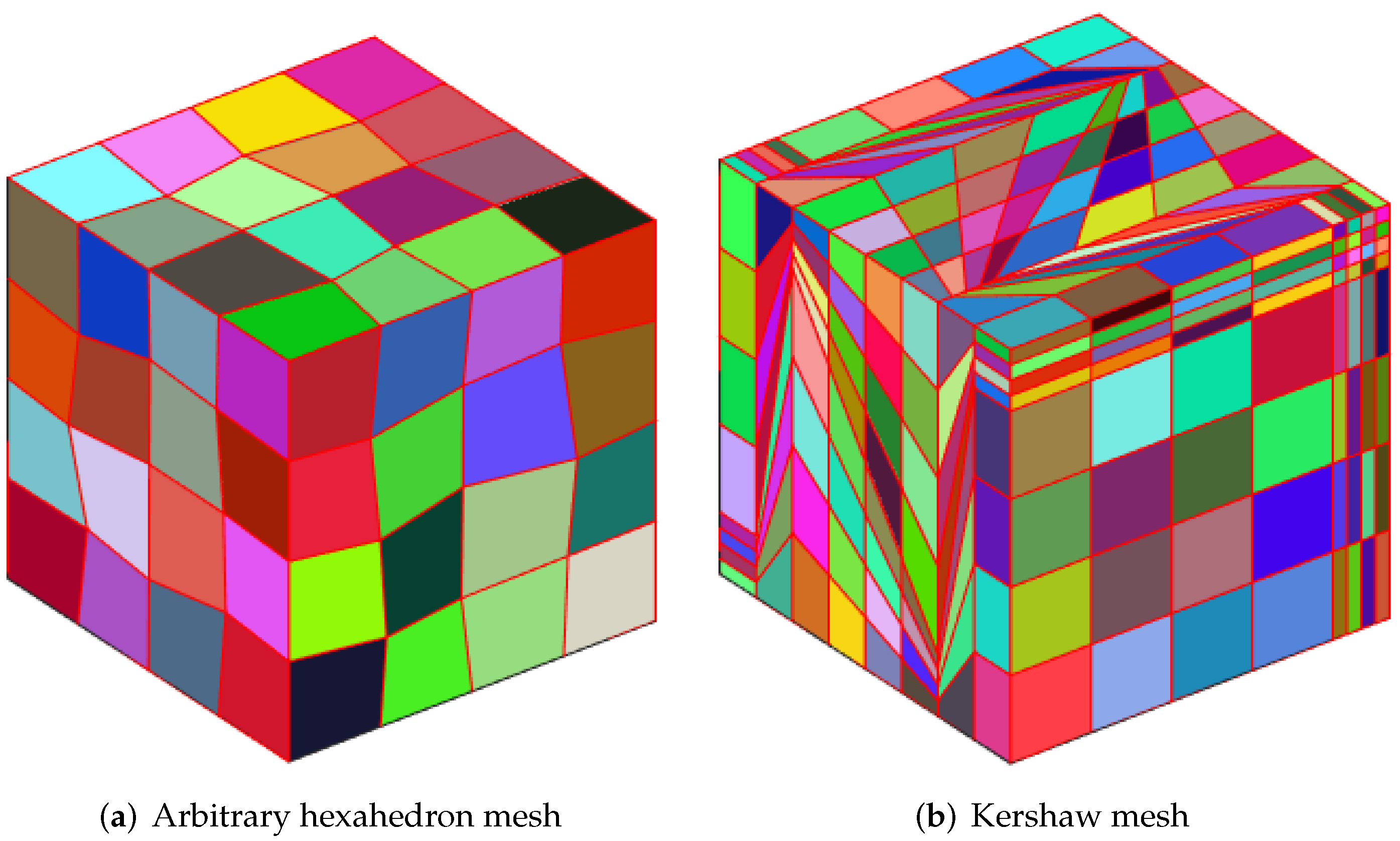
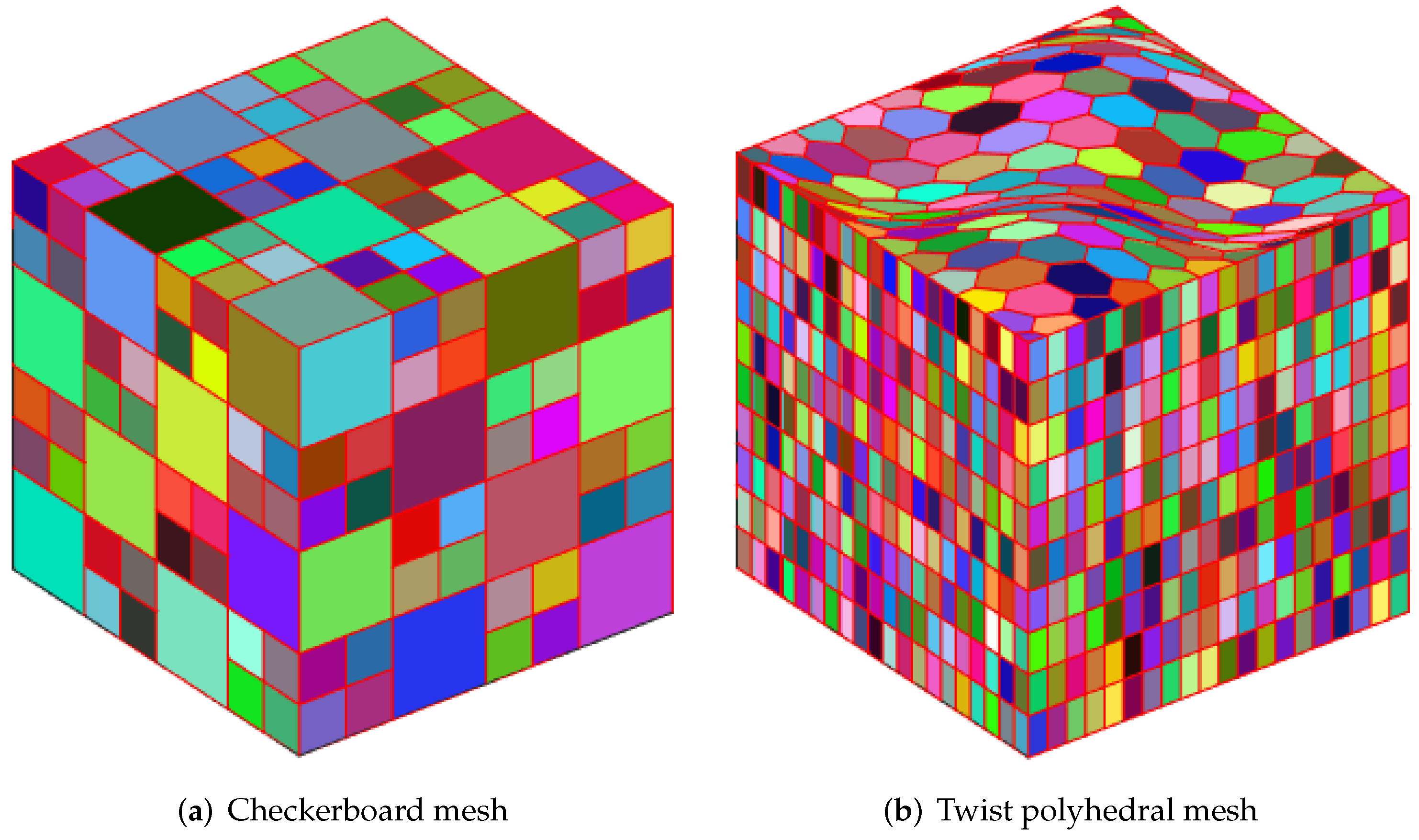
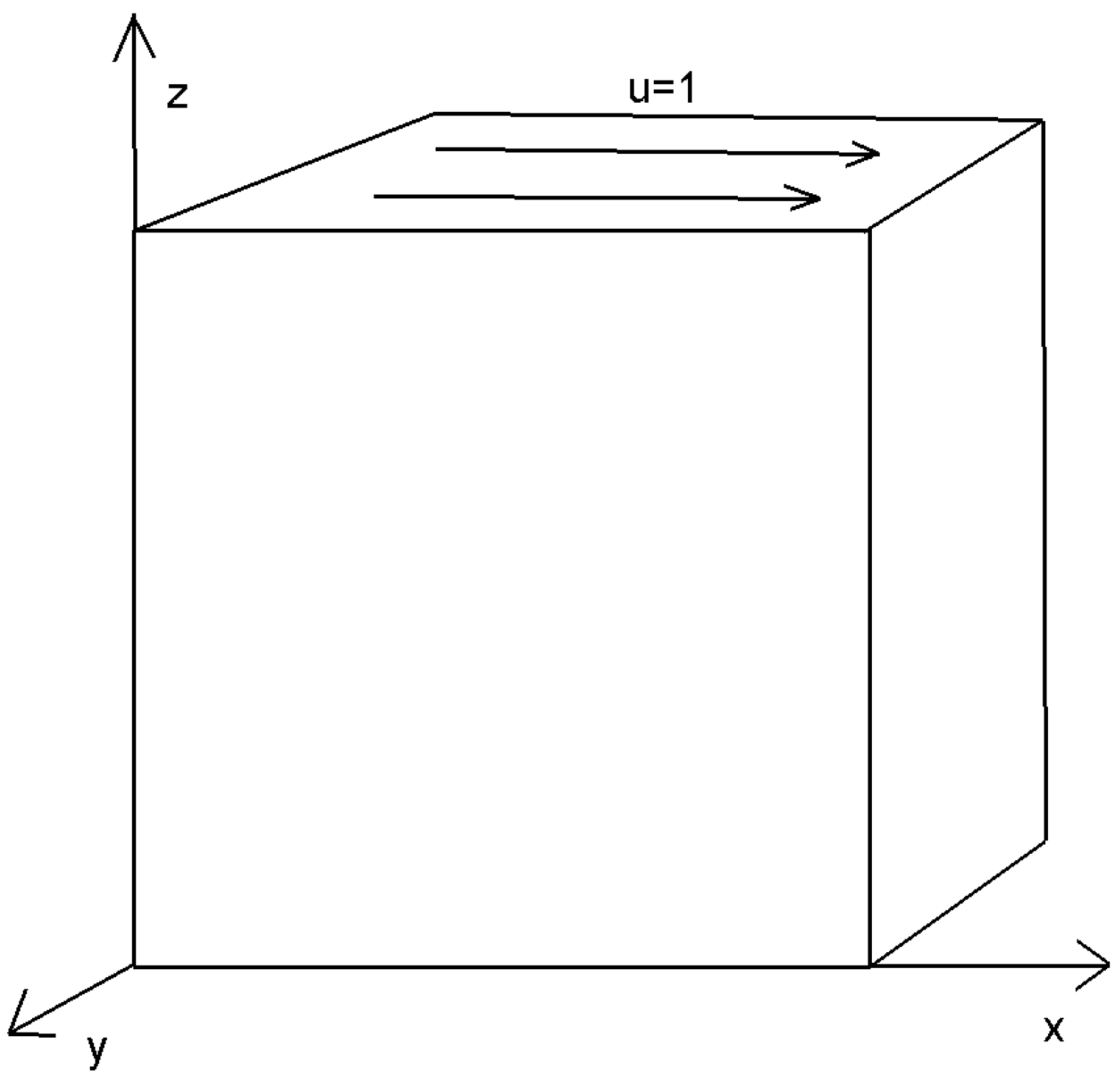
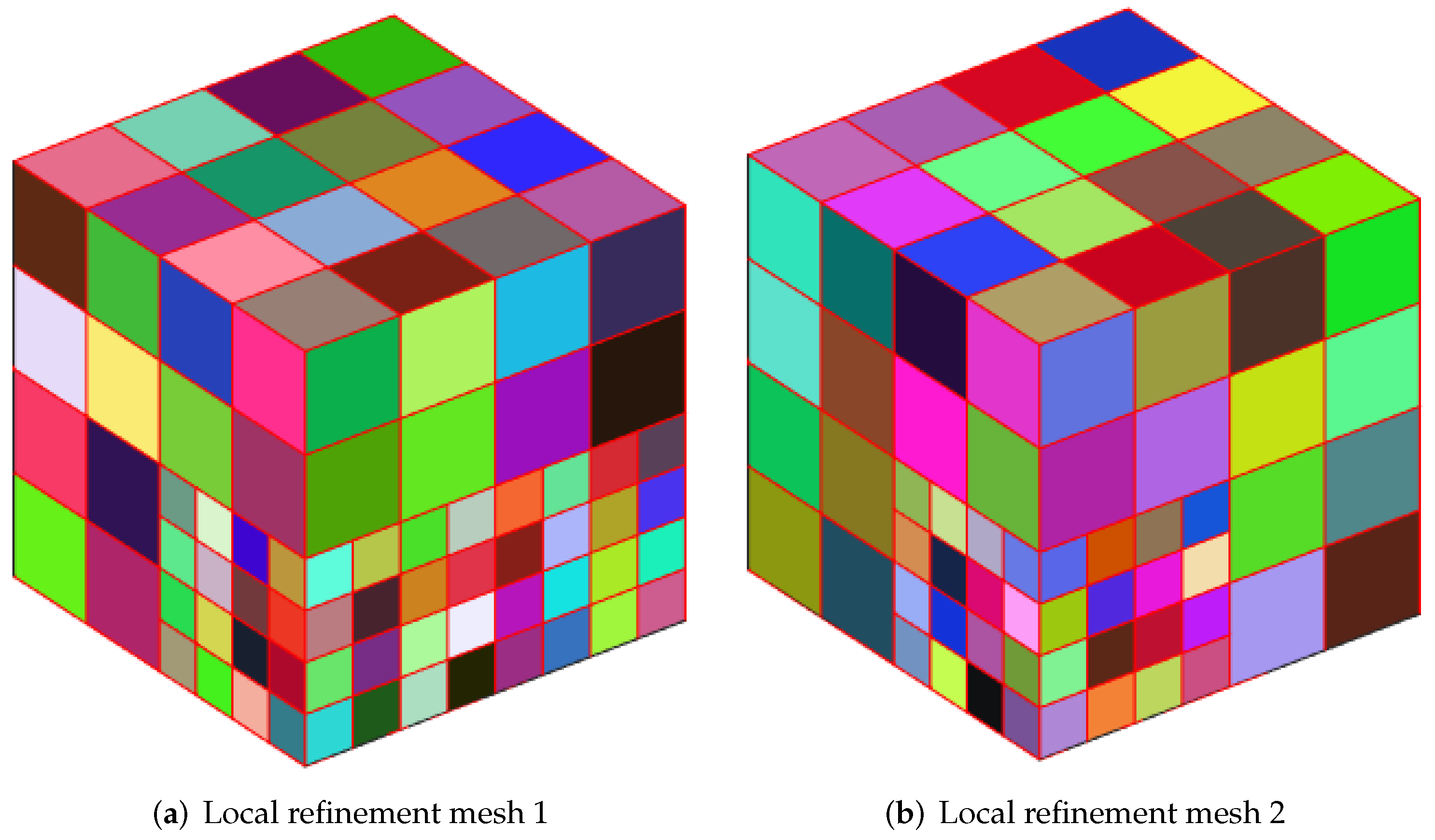
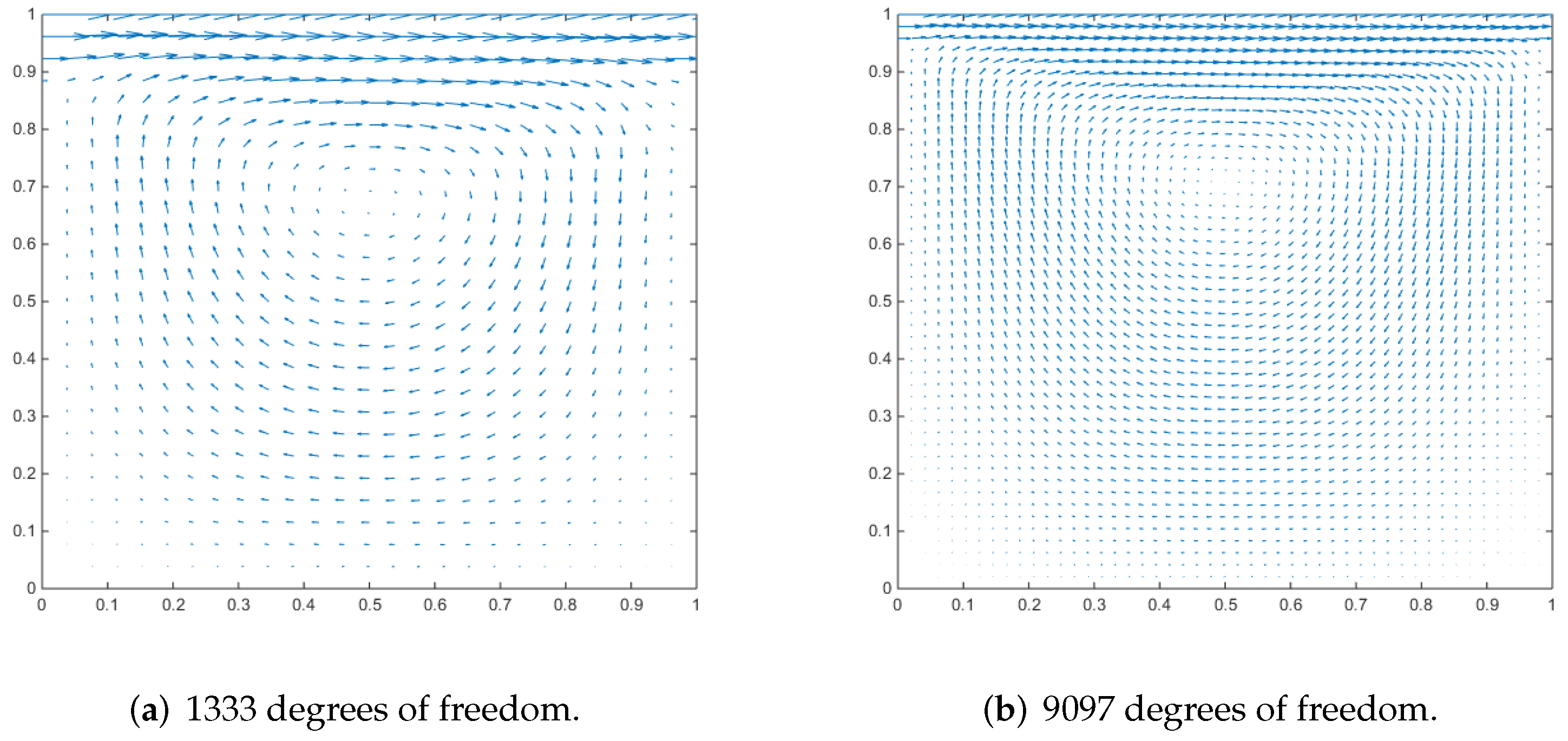
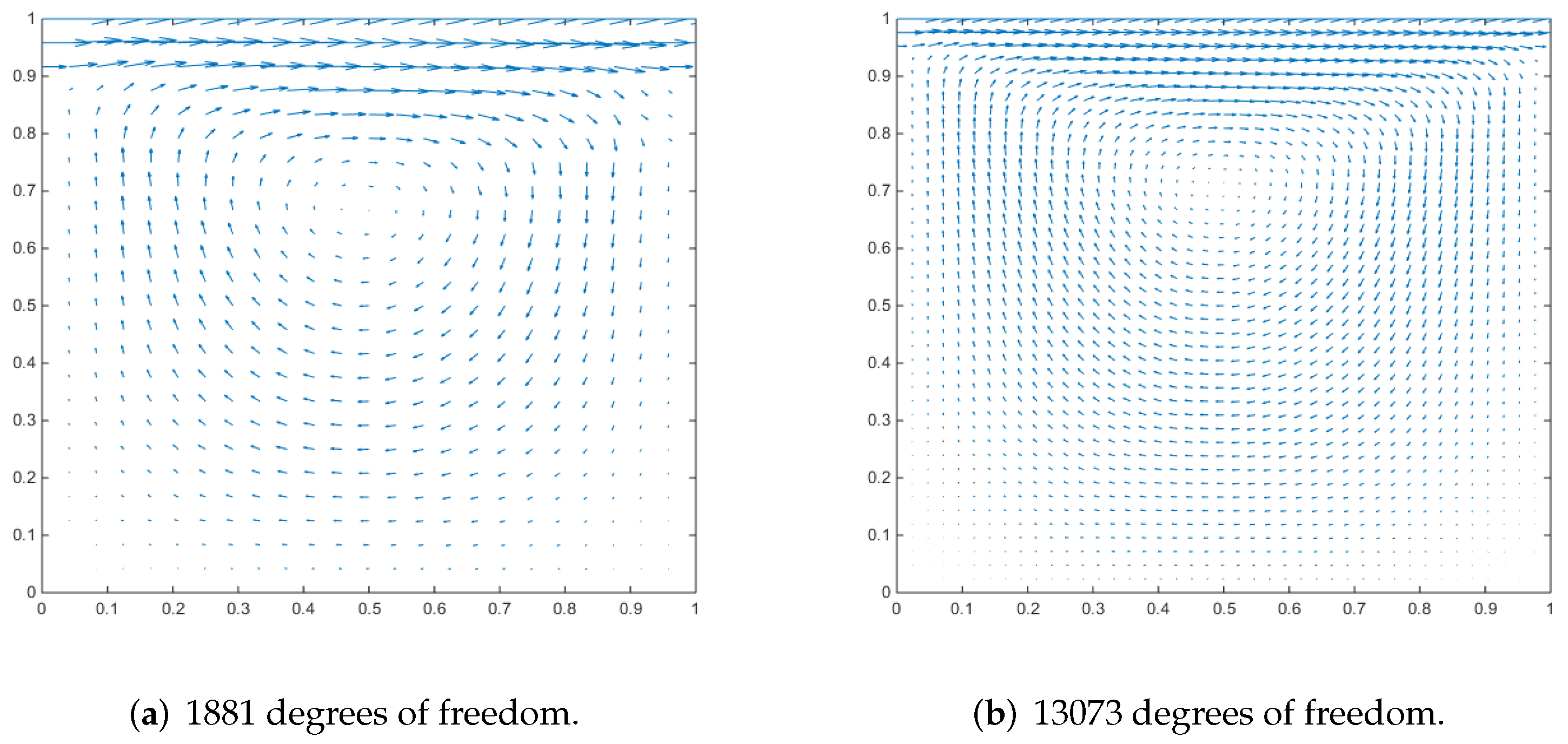
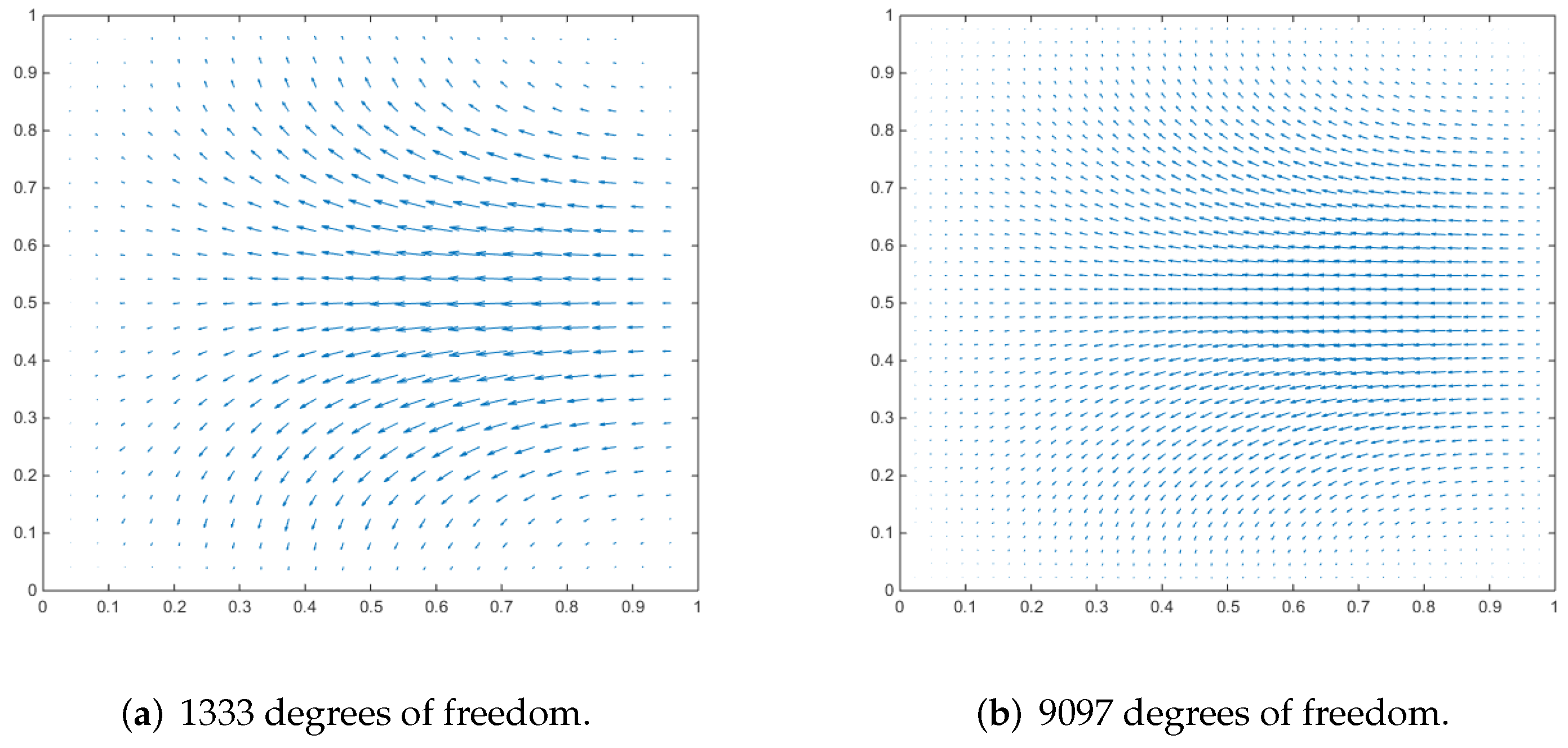
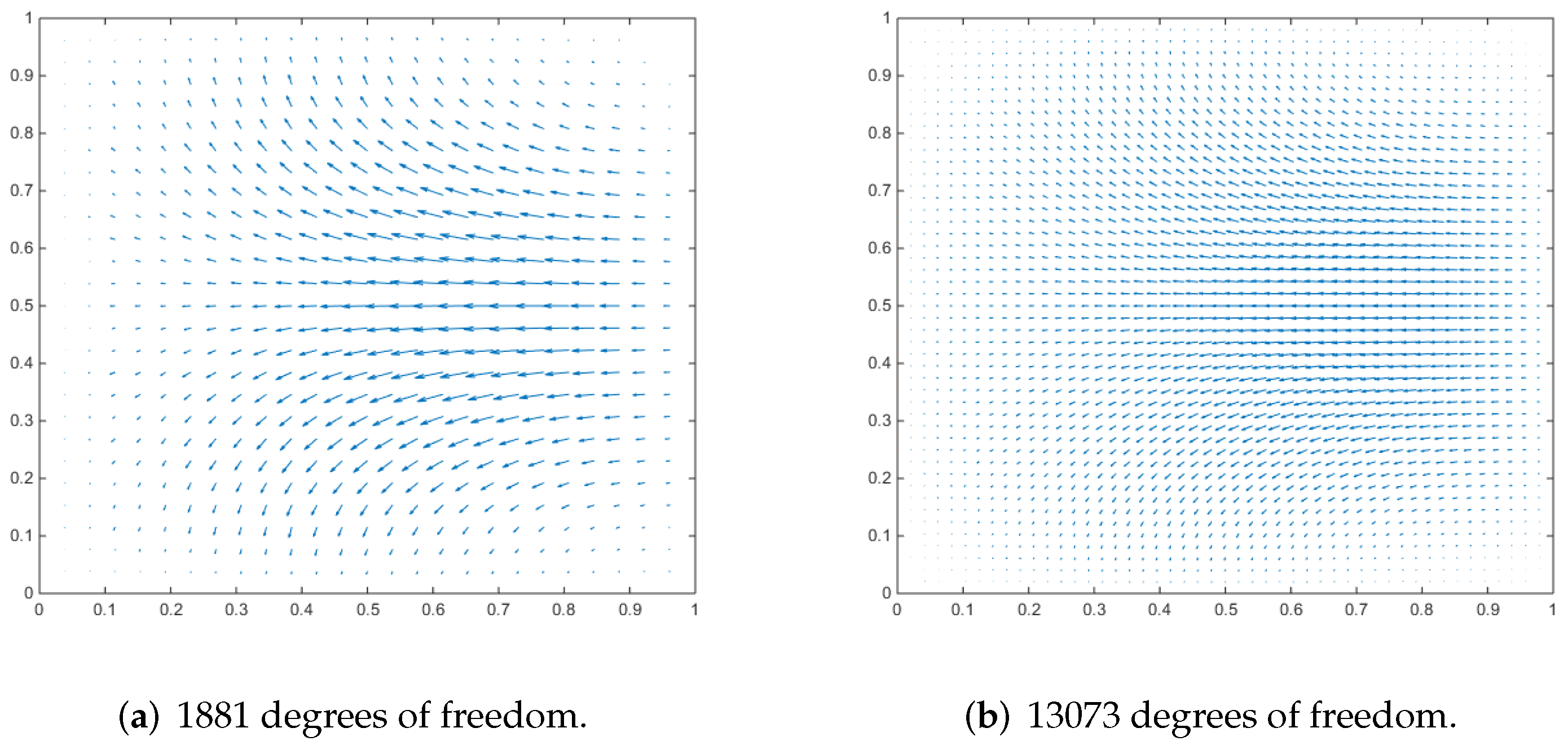
| 729 | 1.2090 × 10 | - | 8.0410 × 10 | - | 1.1038 × 10 | - |
| 4913 | 6.3291 × 10 | 1.0177 | 2.2149 × 10 | 2.0273 | 5.6913 × 10 | 1.0471 |
| 35,937 | 3.1722 × 10 | 1.0414 | 5.7288 × 10 | 2.0387 | 2.7656 × 10 | 1.0827 |
| 729 | 6.3351 × 10 | - | 2.3690 × 10 | - | 8.2720 × 10 | - |
| 4913 | 3.0385 × 10 | 1.1553 | 6.9287 × 10 | 1.9330 | 4.8572 × 10 | 0.8371 |
| 35,937 | 1.4716 × 10 | 1.0930 | 1.8020 × 10 | 2.0304 | 2.5461 × 10 | 0.9737 |
| 625 | 2.1395× 10 | - | 1.0443× 10 | - | 3.3572× 10 | - |
| 4417 | 1.1618× 10 | 0.9368 | 3.1281× 10 | 1.8494 | 1.8848× 10 | 0.8857 |
| 33,025 | 6.1371× 10 | 0.9517 | 3.0917× 10 | 1.9741 | 8.9848× 10 | 0.9878 |
| 3080 | 6.6406× 10 | - | 2.1750× 10 | - | 1.6897× 10 | - |
| 20,160 | 3.3853× 10 | 1.0759 | 6.0897× 10 | 2.0327 | 8.6744× 10 | 1.0647 |
| 63,240 | 2.2962× 10 | 1.0187 | 2.9105× 10 | 1.9373 | 5.8729× 10 | 1.0235 |
Publisher’s Note: MDPI stays neutral with regard to jurisdictional claims in published maps and institutional affiliations. |
© 2022 by the authors. Licensee MDPI, Basel, Switzerland. This article is an open access article distributed under the terms and conditions of the Creative Commons Attribution (CC BY) license (https://creativecommons.org/licenses/by/4.0/).
Share and Cite
Li, L.; Su, H.; He, Y. Penalty Virtual Element Method for the 3D Incompressible Flow on Polyhedron Mesh. Entropy 2022, 24, 1129. https://doi.org/10.3390/e24081129
Li L, Su H, He Y. Penalty Virtual Element Method for the 3D Incompressible Flow on Polyhedron Mesh. Entropy. 2022; 24(8):1129. https://doi.org/10.3390/e24081129
Chicago/Turabian StyleLi, Lulu, Haiyan Su, and Yinnian He. 2022. "Penalty Virtual Element Method for the 3D Incompressible Flow on Polyhedron Mesh" Entropy 24, no. 8: 1129. https://doi.org/10.3390/e24081129
APA StyleLi, L., Su, H., & He, Y. (2022). Penalty Virtual Element Method for the 3D Incompressible Flow on Polyhedron Mesh. Entropy, 24(8), 1129. https://doi.org/10.3390/e24081129






